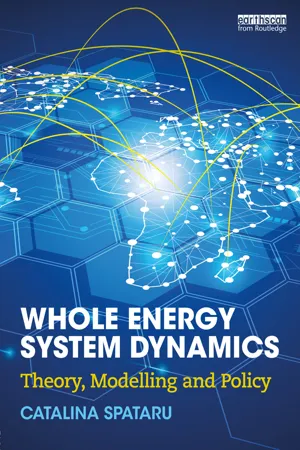
- 224 pages
- English
- ePUB (mobile friendly)
- Available on iOS & Android
About This Book
In order to address the twenty-first-century challenges of decarbonisation, energy security and cost-effectiveness it is essential to understand whole energy systems and the interconnection and interaction between different components. An integrated language is therefore needed to assist energy policymakers and to help industrial stakeholders assess future energy systems and infrastructure and make realistic technical and economic decisions.
Whole Energy System Dynamics provides an interdisciplinary approach to whole energy systems; providing insights and understanding of it in the context of challenges, opportunities and solutions at different levels and time steps. It discusses approaches across disciplinary boundaries as well as existing issues within three main themes: theory, modelling and policy, and their interlinkage with geopolitics, markets and practice. Spataru argues that there is an urgent need for a whole energy system integration. This is necessary for effective analysis, design and control of the interactions and interdependencies involved in the technical, economic, regulatory and social dimensions of the energy system.
This book is essential reading for students interested in the area of energy systems, policy and modelling. It is also a valuable read for policymakers, professionals, researchers, academics, engineers and industrial stakeholders.
Frequently asked questions
Information
Part I
Theory and history
Prologue
1Global energy systems
A historical perspective
1.1 The three pillars of human development and progress
a) Economic growth across space and time
b) Human global population growth over time and space
Table of contents
- Cover
- Half Title
- Title Page
- Copyright Page
- Table Of Contents
- List of illustrations
- Preface
- Acknowledgements
- List of abbreviations
- PART I Theory and history
- PART II Modelling: challenges and discussions
- PART III Energy policy, markets and geopolitics
- Appendix A: constructing a metadatabase from open data sources
- Appendix B: a compilation of open data sources
- Appendix C: a compilation of energy systems models available online
- Index